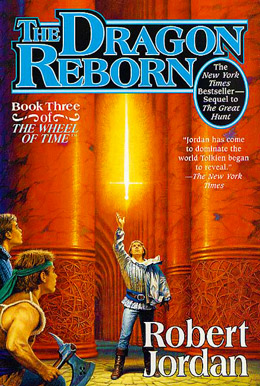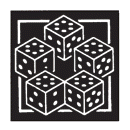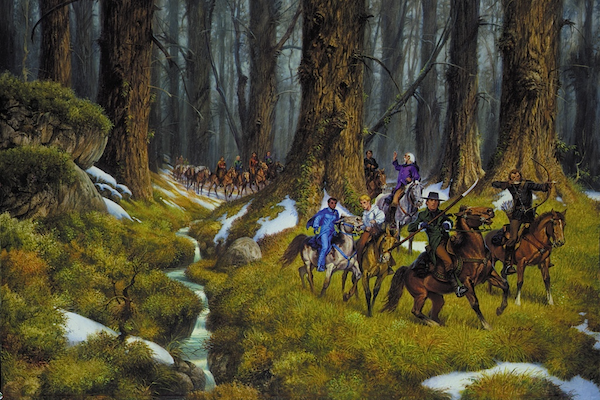Punishment for skipping the Wheel of Time Reread Redux is three days’ suspension and refusal of your prom tickets! Okay, not really. But I’ll be sad. You don’t want to make me sad, do you? *sniffle*
Today’s Redux post will cover Chapters 28 and 29 of The Dragon Reborn, originally reread in this post.
All original posts are listed in The Wheel of Time Reread Index here, and all Redux posts will also be archived there as well. (The Wheel of Time Master Index, as always, is here, which has links to news, reviews, interviews, and all manner of information about the Wheel of Time in general on Tor.com.)
The Wheel of Time Reread is also available as an e-book series! Yay!
All Reread Redux posts will contain spoilers for the entire Wheel of Time series, so if you haven’t read, read at your own risk.
And now, the post!
So before starting with the chapters, I have to take a moment to chuckle at the intro of the original post, which is, I think, the first full-blown example of my intermittent penchant for coming up with, shall we say, unorthodox openers for Reread posts when the mood struck me. I have no idea why I started doing them, but they were frequently one of the parts of composing the Reread that I most enjoyed, even when they were also often one of the most frustrating parts to get right.
This particular whimsicality is owed to Carrie (the vastly superior 1976 version, natch), that awesomely horrible teacher in Willy Wonka and the Chocolate Factory (the vastly superior 1971 version, natch), and my 7th grade English teacher, whom I devoutly hope is retired by now and living a quiet tranquil life far from any Billys.
And, wow. That was… a surprising number of 7s.
Er. Onward!
Chapter 28: A Way Out
Ah, yes. This is where I introduced my whole theory about gender-flipped commentary in WOT. Which is something I still think works as an analysis, even though I’m glad I noted from the outset that it was an imperfect application both in effectiveness and in 1:1 correlation. Meaning, I don’t think this was always the intent, and even when and if it might have been, it didn’t always accomplish what it might have meant to do.
That said, it’s a useful and illustrative exercise for any work of fiction, not just WOT, regardless of what the author’s intentions may or may not have been concerning gender roles. If you are a writer, it is an excellent way to identify how your story may be unconsciously reflecting gender stereotypes, and addressing those does a lot more than just make your story less offensive; it also makes your story less boring, which in some ways may even be the bigger sin to commit.
Anyway, even though I didn’t bring it up in the original commentary, this chapter is also just as good an example of one of my frustrations with Jordan’s portrayal of gender politics, which is how the interactions of his male and female characters always seem to be so damn combative. Mat and the Supergirls’ interaction in this chapter (and in most other chapters) is probably better characterized as a fencing match than a conversation, and this is true of probably about 95% of every single male-female interaction in the entire series.
Granted, it’s not like there isn’t plenty of verbal fencing going on between characters of the same gender (hello, Aes Sedai), but there seems to be a quality of… I dunno, constant mutual bafflement in the mixed-gender tussles that I sometimes feel is just a tad over-exaggerated. Like, these bizarre alien men/women, how do their brains even work? IT’S ALL SO MYSTERIOUS.
Needless to say, I am not a subscriber to the belief that men and women are from completely different planets when it comes to how they tick; we are all human first and foremost, in my view, and we are all much more alike than we aren’t, no matter what society would prefer us to believe. In my opinion the view that one gender is just fundamentally incomprehensible to the other has done much more harm than it has provided amusement, in the long run.
But, the “battle of the sexes” motif as played for comedy has been a thing for a very long time, in various incarnations, and I suspect that that is at least partially what Jordan was going for with the clashes between his male and female characters. I just think that sometimes he laid it on a bit thick…
They stayed awhile longer, talking of home for the most part. Egwene and Elayne sat on the bed, and Nynaeve took the armchair, while he kept his stool. Talk of Emond’s Field made him homesick, and it seemed to make Nynaeve and Egwene sad, as if they were speaking of something they would never see again. He was sure their eyes moistened, but when he tried to change the subject, they brought it back again, to people they knew, to the festivals of Bel Tine and Sunday, to harvest dances and picnic gatherings for the shearing.
…An impression strengthened by his tendency to skim over the rare parts of their interaction that weren’t fraught with conflict. I suppose this falls under the aegis of “skipping over the boring bits”, but I don’t know, I think it might have been worth it to include at least a little more emphasis on men and women just talking to each other like people, instead of opponents, even if it is a little mundane. Just for balance, you know?
Chapter 29: A Trap to Spring
I opined in the original commentary that it was bizarre that we never got to see the day-to-day workings of the Tower, like the girls going to class or interacting with their peers and so forth. And while there is still a part of me that thinks a school story treatment of the Tower would be fascinating to read, I have to admit that criticizing WOT for its failure to include it is really not kosher.
For one thing, that’s a completely different kind of story from the one Jordan was telling. This is not to say one cannot combine school-age drama with apocalyptic goings-on, as anyone who hasn’t been living under a rock for the last twenty years is probably aware, but if that’s not the kind of genre mashup you’ve been going for from the beginning, a foray into the minutiae of life as a Tower initiate in WOT can only be viewed as a tangential digression at best. And considering how much crap we’ve all given Jordan over the years for the tangents he does go on, harping on his failure to include yet another digression is probably a little rich.
So, in conclusion, shut up, Past Leigh. Heh. (Although, my thoughts on the subject, ba dum dum, are probably what inspired the classroom shtick for the intro, so it’s not all bad.)
[Siuan:] “But there is news that could not wait. Sheriam found another Gray Man. A woman. Dead as last week’s fish, and not a mark on her. She was laid out as if resting, right in the middle of Sheriam’s bed. Not very pleasant for Sheriam.”
Knowing now that Sheriam is Black Ajah, it’s pretty easy to speculate about the whole unseen drama going on behind the scenes here. Given that she was apparently a fairly apathetic member of the Evil League of Evil (I can see no other explanation of why she didn’t take advantage of her high-ranking position, both pre- and post-schism, to do vastly more damage than she did), it seems clear in retrospect that the second Gray Man was intended as a warning for Sheriam, probably along the lines of get off your ass and be more Evil, woman, or else. So that’s one more mystery retroactively cleared up, which is nice.
And lastly, I guess it seems that “she’s Arafellin” really is the explanation for all of Alanna’s funky behavior throughout the series. Yay?
And with that, school’s out for now, kids! Have a lovely week, and I’ll see you next Tuesday!















